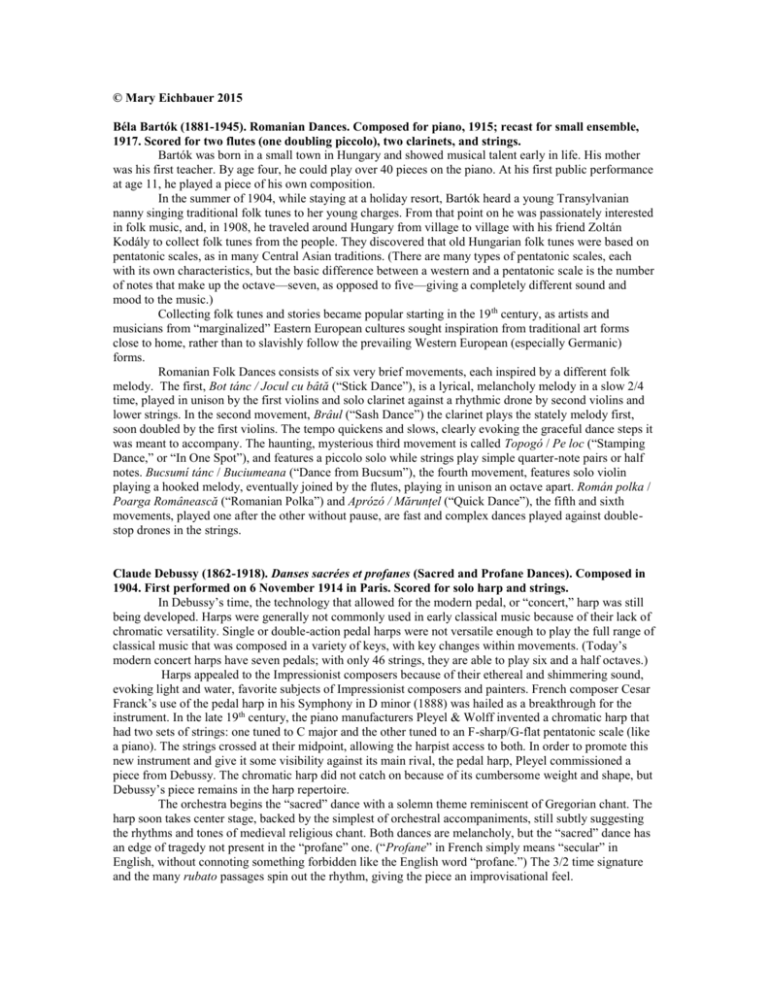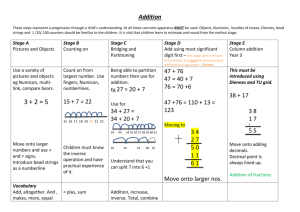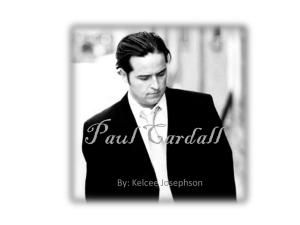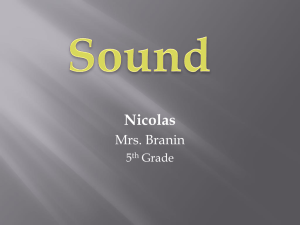© Mary Eichbauer 2015
advertisement

© Mary Eichbauer 2015 Béla Bartók (1881-1945). Romanian Dances. Composed for piano, 1915; recast for small ensemble, 1917. Scored for two flutes (one doubling piccolo), two clarinets, and strings. Bartók was born in a small town in Hungary and showed musical talent early in life. His mother was his first teacher. By age four, he could play over 40 pieces on the piano. At his first public performance at age 11, he played a piece of his own composition. In the summer of 1904, while staying at a holiday resort, Bartók heard a young Transylvanian nanny singing traditional folk tunes to her young charges. From that point on he was passionately interested in folk music, and, in 1908, he traveled around Hungary from village to village with his friend Zoltán Kodály to collect folk tunes from the people. They discovered that old Hungarian folk tunes were based on pentatonic scales, as in many Central Asian traditions. (There are many types of pentatonic scales, each with its own characteristics, but the basic difference between a western and a pentatonic scale is the number of notes that make up the octave—seven, as opposed to five—giving a completely different sound and mood to the music.) Collecting folk tunes and stories became popular starting in the 19 th century, as artists and musicians from “marginalized” Eastern European cultures sought inspiration from traditional art forms close to home, rather than to slavishly follow the prevailing Western European (especially Germanic) forms. Romanian Folk Dances consists of six very brief movements, each inspired by a different folk melody. The first, Bot tánc / Jocul cu bâtă (“Stick Dance”), is a lyrical, melancholy melody in a slow 2/4 time, played in unison by the first violins and solo clarinet against a rhythmic drone by second violins and lower strings. In the second movement, Brâul (“Sash Dance”) the clarinet plays the stately melody first, soon doubled by the first violins. The tempo quickens and slows, clearly evoking the graceful dance steps it was meant to accompany. The haunting, mysterious third movement is called Topogó / Pe loc (“Stamping Dance,” or “In One Spot”), and features a piccolo solo while strings play simple quarter-note pairs or half notes. Bucsumí tánc / Buciumeana (“Dance from Bucsum”), the fourth movement, features solo violin playing a hooked melody, eventually joined by the flutes, playing in unison an octave apart. Román polka / Poarga Românească (“Romanian Polka”) and Aprózó / Mărunțel (“Quick Dance”), the fifth and sixth movements, played one after the other without pause, are fast and complex dances played against doublestop drones in the strings. Claude Debussy (1862-1918). Danses sacrées et profanes (Sacred and Profane Dances). Composed in 1904. First performed on 6 November 1914 in Paris. Scored for solo harp and strings. In Debussy’s time, the technology that allowed for the modern pedal, or “concert,” harp was still being developed. Harps were generally not commonly used in early classical music because of their lack of chromatic versatility. Single or double-action pedal harps were not versatile enough to play the full range of classical music that was composed in a variety of keys, with key changes within movements. (Today’s modern concert harps have seven pedals; with only 46 strings, they are able to play six and a half octaves.) Harps appealed to the Impressionist composers because of their ethereal and shimmering sound, evoking light and water, favorite subjects of Impressionist composers and painters. French composer Cesar Franck’s use of the pedal harp in his Symphony in D minor (1888) was hailed as a breakthrough for the instrument. In the late 19th century, the piano manufacturers Pleyel & Wolff invented a chromatic harp that had two sets of strings: one tuned to C major and the other tuned to an F-sharp/G-flat pentatonic scale (like a piano). The strings crossed at their midpoint, allowing the harpist access to both. In order to promote this new instrument and give it some visibility against its main rival, the pedal harp, Pleyel commissioned a piece from Debussy. The chromatic harp did not catch on because of its cumbersome weight and shape, but Debussy’s piece remains in the harp repertoire. The orchestra begins the “sacred” dance with a solemn theme reminiscent of Gregorian chant. The harp soon takes center stage, backed by the simplest of orchestral accompaniments, still subtly suggesting the rhythms and tones of medieval religious chant. Both dances are melancholy, but the “sacred” dance has an edge of tragedy not present in the “profane” one. (“Profane” in French simply means “secular” in English, without connoting something forbidden like the English word “profane.”) The 3/2 time signature and the many rubato passages spin out the rhythm, giving the piece an improvisational feel. Played without a break, the “secular” dance does not differ radically from the “sacred” dance, except that it is perhaps more cheerful and sensual. We move from the languorous 3/2 time to the more “common” waltz time of 3/4, creating a feeling of quickening that is enhanced by the orchestra’s playful crescendos and decrescendos. After a harp cadenza, the opening orchestral theme recurs, and after a lush passage where the dynamic marking for the orchestra reaches fortissimo before dropping back to piano, the harp plays a dissonant chord, and the strings end with a single pizzicato note. Maurice Ravel (1875-1937). Introduction and Allegro. Composed in June 1905. First performed 22 February 1907 in Paris. Scored for flute, clarinet, solo harp, and strings. It is no accident that this piece should turn up on the same program as Debussy’s Sacred and Profane Dances, for it was commissioned by the Erard Company, rival of Pleyel, to illustrate the virtues of the pedal harp over its newcomer rival, the chromatic harp. While Debussy, in Sacred and Profane Dances, reduces the accompaniment to a spectral background role, Ravel, the consummate orchestrator, uses strings and winds as full partners to the solo harp in Introduction and Allegro. Every instrument’s capacity for creating different qualities of sound is used to the fullest. Strings play harmonics, tremolo, pizzicato, sul tasto (over the fingerboard); they make quick string crossings and play sharp staccato notes and long, drawn out, lyrical legato phrases. Winds play ostinato arpeggios and staccato. The harp part is lush and complex, full of plucked notes, harmonics, and shimmering runs, covering its entire range from high to low. Although Ravel wrote this piece in one frenzied week before leaving on vacation, while Debussy took his time, Ravel probably wins for sheer orchestral color. Flute and clarinet play a brief, haunting phrase to introduce the harp. Now the strings repeat the phrase. The harp’s answer is all shimmer. A cello solo with accompanying texture from flute, clarinet, and violins spins out the phrase until the harp reenters and plays against the accompaniment and then alone. The harp introduces a new theme picked up by the flute and then clarinet and strings. The tempo quickens and slows; excitement is generated only to dissipate once more, but always we return to solo passages by the harp in different moods and colors, imitating and being imitated by the other instruments. At the end, excitement builds until the harp ends the piece on a swift flight upwards. Francis Poulenc (1899-1963). Deux marches et un intermède (Two Marches and an Interlude). Composed 1937. Scored for flute, oboe, clarinet, bassoon, trumpet, and strings. Francis Poulenc was born into a devout Catholic family, owners of the pharmaceutical manufacturing company that later developed into Rhône-Poulenc. Although his mother was musical, the family did not consider music a serious profession for a young man from a good family, and so Francis did not receive a formal musical education, though he took piano and studied music informally. By the time he was 18, both his parents had died, and he became involved with a group of young composers—protégés of Erik Satie—who collectively were known as “Les Six.” (Arthur Honegger was also one of them.) Poulenc’s music justifies a remark made about him by critic Claude Rostand, to the effect that he was “half monk and half delinquent.” There is a jaunty irreverence about much of his work, and yet late in his career he also composed serious religious works. We can see some of that duality in the second March of this work in the clash between lyric and martial passages, irreverence mixed up with stark foreboding. Two Marches and an Interlude was composed as a commission for 1937 International Exhibition being held in Paris. The occasion was a dinner in the “House of Chemistry.” Who more appropriate to compose a forward-looking work about progress than the son of one of the largest chemical manufacturing companies in France? The first march, called “March 1889,” looks back to the past for inspiration and evokes uniformly cheerful nostalgia for Belle Epoque Paris. Beginning with spiccato strings, its tone is jaunty and irreverent—not at all military. A central section is melodic and breezy, and not march-like at all. The first section repeats to end the short movement. The Intermède champêtre, or Country Interlude, at first evokes a country dance, despite its occasional dissonance and minor-key sound. Some uncomfortable elements arise towards the end, suggesting a clash between city and country, or old and new, and leading to the final movement. The much darker “March 1937” announces the present day with a fanfare played by the strings, not the trumpet, which is given only the merest echo. The theme grows darker and more dissonant as the march slows to a crawl. The only light element is the final upbeat chord. Judging from the mood of this piece, Poulenc was uncertain about the march of progress in 1937, and well he might have been. Arthur Honegger (1892-1955). Pastorale d'été (Spring Pastoral). Composed in August 1920. First performed 17 February 1921 in Paris. Scored for flute, oboe, clarinet, bassoon, horn, and strings. Honegger was born in France to Swiss parents. Unlike his younger friend Poulenc, who lacked much formal music education, Honegger was a graduate of the Zurich and Paris Conservatories. This tone poem, an impression of a peaceful morning in the Alps, is tightly and beautifully orchestrated in order to create a mood of languid contentment, tinged with melancholy, in the listener’s mind. The other members of Les Six were resolutely avant-garde, reacting against the prevalent German Romantic establishment in music. But Honegger’s music seems to embrace that influence, while it also evokes Debussy and the Impressionists. Shortly after composing this piece, Honegger gained great acclaim with his oratorio “King David.” The work starts with a wavelike figure and then a horn solo. Long, legato phrases are punctuated with shimmering notes in the strings and birdsong by the flute. Towards the middle, the pace quickens as the mood turns restless and cheerful by turns, then slows again with bassoon and horn solos recalling the opening theme, giving the impression of meandering water, and the work closes peacefully. Jacques Ibert (1890-1962). Divertissement. Composed in 1929. First performed 30 November 1930 in Paris. Scored for flute (doubling piccolo), clarinet, bassoon (doubling contrabassoon), horn, trumpet, trombone, percussion (timbales, triangle, woodblock, snare drum, suspended cymbals, bass drum, castanets, tamtam, police whistle), piano (doubling celeste), and strings. Born nine years before Poulenc but just two before Honegger, Ibert could also have been part of the avant-garde group Les Six, or he could have been firmly traditional, but he was neither, and both. “All systems are valid,” he famously said, and he cherry-picked from many styles according to what he felt was appropriate for each particular project. “Escales” (“Ports of Call”), the first work to win him acclaim, is written in the impressionist style of Debussy. But, perhaps because he had no allegiance to any particular school or style, Ibert’s favorite mode was pastiche (a mixture of styles used self-consciously for comic effect). Divertissement is a rearrangement into a six-movement suite of incidental music written for a play called “Un chapeau de paille d’Italie” (“An Italian Straw Hat”), which was later made into a silent movie by director René Clair. On his wedding day, a man is out riding, when his horse munches on a lady’s straw hat that is hanging on a bush in the park. Said lady is behind the bush with a lieutenant who is not her husband. If she returns home without her rare Italian straw hat, her husband will become suspicious. The lieutenant threatens the horse’s owner, who then goes on a whirlwind quest of misadventures all over Paris for an exact double of the eaten hat, only to eventually find one at home among the wedding gifts left for himself and his bride. Ibert composed ballets and operas, as well as incidental music for stage and screen. He worked not only with Orson Welles and Gene Kelly, but with many well-known French theater and film directors. His brash, skillful technique that spans all styles but settles on none has earned his work the sobriquet “eclectic.” I. Introduction. Allegro vivo. This brash overture creates excitement and anticipation, and sets the stage for the zany story to come. II. Cortège. Moderato molto. From a quiet, pastoral beginning in the impressionist style, where a distant piccolo twitters like a bird, a quick tempo change to a two-step march illustrates for us the intrusion of chaos into the hero’s ordered life. A lovely little string interlude doesn’t last long in the face of chaos. A quotation from Mendelssohn’s “Wedding March,” followed by a representation of marching footsteps and then a sarcastic brass “laugh” represents the joke played by fate on a man who just wants to be peacefully married but, because of a horse, ends up with a crowd of bothersome strangers in his life. III. Nocturne. Lento. The Nocturne is a moody change of pace played by lower strings with a foreboding and spooky piano line. Rising scales lead directly into the next number. IV. Valse. Animato assai. This farcical waltz sends up every waltz you have ever heard, first with mincing winds and then overly expansive strings. It’s cleverly orchestrated, but always on the edge of annoying—it’s a too little fast and a little too shrill, and the brass frankly sounds a little drunk. Too much is always going on; it’s a thrill ride, as when the trumpet plays an expansive theme over a noodling clarinet. A cymbal crash is funny for being over the top, and the trombone can’t stop laughing. It all ends in a whirlwind. V. Parade. Tempo di Marcia A marching piano with distant bugle calls by all instruments begins this parade. Then we switch to a quick walking tempo that becomes a drinking song. The military march returns to end the movement quietly. VI. Finale. Quasi cadenza. “Quasi (“Almost”) cadenza” turns out to be a joke—the pianist bangs random keys on the piano instead of playing a gorgeous solo piece, which is what we usually think of as a cadenza. And then all hell breaks loose, to the tune of frantic circus music. We hear a chase, with police, and galloping, and occasional loud guffaws by the brass, until it all comes to a screaming conclusion.




![History of Stringed Instruments[1]](http://s2.studylib.net/store/data/005707415_1-12ec8f4b44824912a5e4c3c8d559fe82-300x300.png)



